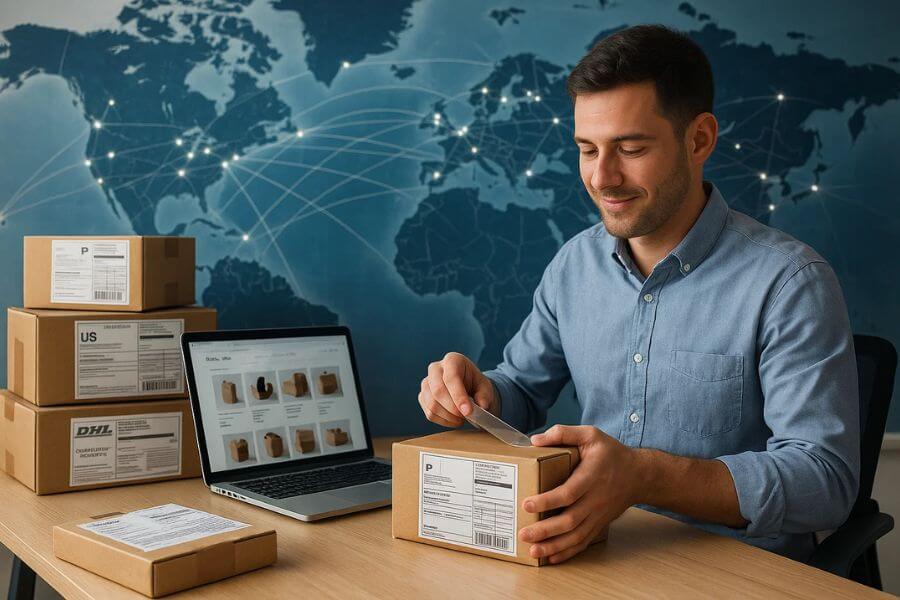International ecommerce can be a game-changer for small and medium-sized enterprises (SMEs). It offers the chance to reach customers in different countries, diversify revenue streams, and build a truly global brand. But one major obstacle stands in the way: cross-border trade complexities.
From customs duties to import taxes, the extra costs and paperwork involved in international shipping can quickly turn an exciting growth opportunity into a logistical headache. Many SMEs shy away from selling abroad because they assume it’s too complicated or too expensive.
That’s where de minimis rules come in, a powerful, often underutilized tool for ecommerce businesses.
In customs terms, “de minimis” refers to the threshold value below which imported goods can enter a country without incurring duties or taxes, and often with minimal customs paperwork. This value varies by country and can have a huge impact on your shipping strategy.
For example:
- In the United States, the de minimis threshold is $800, one of the highest in the world
- In Australia, it’s AUD 1,000
- In Canada, it’s CAD 40 for taxes and CAD 150 for duties (under CUSMA rules)
For small ecommerce businesses, understanding and leveraging these thresholds can reduce costs, speed up shipping, and boost customer satisfaction.
In this guide, we’ll break down 10 major benefits of de minimis rules for small and medium-sized ecommerce businesses and show you how to turn them into a competitive advantage.
1. Lower import costs for customers
One of the top reasons customers hesitate to buy from an overseas seller is the fear of hidden fees. Imagine finding the perfect $60 product online, only to discover at checkout, or worse, upon delivery, that you need to pay an extra $25 in import duties. That’s a deal breaker for many.
De minimis thresholds eliminate this problem for eligible orders. If your product price is under a country’s threshold, customers won’t have to pay import duties, and in some cases, they won’t have to pay value-added tax (VAT) either.
Example:
Let’s say you sell handmade leather wallets from Italy. Shipping to U.S. customers means your $75 wallet is duty-free because the order value is well below the $800 U.S. de minimis threshold. Your customer gets the exact price they saw on your website, without any surprise fees.
Why this matters for SMEs:
- Higher conversion rates: Customers are more likely to complete the purchase when the total price is transparent
- Reduced cart abandonment: Research shows unexpected costs are one of the biggest reasons shoppers abandon their carts
- Better customer loyalty: When people trust your pricing, they return for repeat purchases
In essence, lower import costs make your products more competitive and attractive in international markets, especially against local sellers.
2. Faster customs clearance
Customs delays are the bane of international ecommerce. Shipments stuck in inspection not only frustrate customers but also damage your brand’s reputation. De minimis rules can significantly speed up the process.
Goods below the de minimis value often:
- Skip extensive customs inspections
- Require minimal documentation
- Are processed through express clearance channels
Example:
If you send a $40 cosmetic product from South Korea to a U.S. customer, the package may clear customs within hours instead of days because it qualifies for duty-free processing.
Benefits to your business:
- Shorter delivery times mean happier customers
- Fewer customer service issues related to delayed shipments
- Higher repeat purchase rates because of reliability
Speed is a competitive advantage in ecommerce. The faster your product reaches your customer, the more likely they are to buy from you again rather than a competitor.
3. Increased cross-border sales
Selling internationally comes with a challenge: convincing customers to buy from a foreign seller instead of a local one. High import duties can make your prices uncompetitive, even if your base price is lower.
De minimis rules help remove this barrier. If your products are below the threshold, you can advertise them as duty-free in target markets.
Case study:
A small jewelry maker in Thailand started promoting their U.S.-bound orders as “Duty-Free Under $800.” They saw a 40% increase in U.S. sales within six months because customers knew they wouldn’t face extra charges.
How SMEs can use this:
- Add “No Import Duty” badges to product listings
- Include messaging like “Delivered at the Price You See” in marketing campaigns
- Use the benefit to justify slightly higher shipping rates while still keeping the total cost lower than that of competitors
By clearly communicating the de minimis advantage, you make your store more appealing to international shoppers.
4. Lower shipping and handling costs
International shipping costs aren’t just about carrier fees; there are hidden costs like customs brokerage fees, storage charges, and document handling costs. Many of these can be reduced or eliminated with de minimis shipments.
Savings opportunities:
- No customs broker fees for low-value shipments
- Avoidance of customs warehouse storage fees due to faster processing
- Lower carrier handling charges for simple clearance procedures
Over time, these savings can add up. For an SME shipping hundreds of small orders per month, reduced handling fees can mean thousands of dollars saved annually, money that can be reinvested in marketing or product development.
5. Better customer experience and trust
Trust is currency in ecommerce. When customers get exactly what they paid for, with no surprises, they’re far more likely to shop with you again.
Common trust killers include:
- Unexpected duties upon delivery
- Long customs delays
- Confusing communication about total costs
De minimis rules help avoid all of these issues. By staying under the threshold and communicating this clearly, you:
- Set accurate expectations
- Deliver on your promises
- Build a loyal customer base
Positive customer experiences don’t just result in repeat sales; they also lead to word-of-mouth referrals and positive online reviews, which can be a major growth driver for SMEs.
6. Competitive pricing advantage
In many cases, a small difference in price can sway a customer’s decision. If your competitors’ products incur duties while yours don’t, you have a clear pricing edge.
Example:
If a customer is choosing between:
- A local item for $65, and
- Your overseas item for $55 with no extra duties,
Even with a small shipping fee, your offer may come out cheaper overall. This advantage becomes even more powerful in markets with high tariffs on certain product categories.
By strategically pricing your products just below de minimis thresholds, you can win price-sensitive customers without sacrificing profit margins.
7. Easier market testing for new products
Launching in a new market can be risky, especially if you have to deal with complex customs rules and high tariffs. De minimis rules allow SMEs to test the waters with low-risk shipments.
How to leverage this:
- Send small batches of a new product to gauge demand
- Avoid large upfront investments in local warehousing or distribution
- Gather real customer feedback before scaling
This approach is particularly valuable for handmade goods, niche products, or seasonal items where demand is uncertain.
8. Reduced administrative burden
Customs paperwork can be overwhelming for small teams. De minimis shipments usually require simplified documentation, which means:
- Fewer forms to complete
- Less chance of compliance errors
- Less time spent on admin tasks
Some countries even allow for fully electronic submissions for low-value shipments, further streamlining the process.
For SMEs without dedicated logistics staff, this reduction in admin work can be a huge time-saver, freeing up resources for marketing, product development, or customer service.
9. Encourages repeat purchases
The smoother and cheaper the buying experience, the more likely customers are to order again. De minimis-friendly products are ideal for encouraging repeat sales because customers know:
- The price is final
- Delivery will be quick
- There will be no surprise fees
You can even use this in marketing campaigns:
- “Order under $X for Tax-Free Delivery”
- “Hassle-Free International Shipping”
Such messaging not only attracts first-time buyers but also keeps them coming back.
10. Supports global brand growth
Ultimately, de minimis rules are a gateway to global expansion. They allow you to:
- Enter new markets with minimal risk
- Build a reputation for reliable, cost-effective international shipping
- Scale globally without massive infrastructure investments
By mastering these thresholds, SMEs can compete internationally in ways that were once reserved for large corporations with deep pockets.
Conclusion
For small and medium ecommerce businesses, de minimis rules are more than just a technical detail; they’re a strategic advantage. They reduce costs, speed up delivery, simplify paperwork, and improve customer satisfaction.
By understanding and leveraging these thresholds, you can open the door to profitable international growth without the headaches of traditional cross-border trade.





